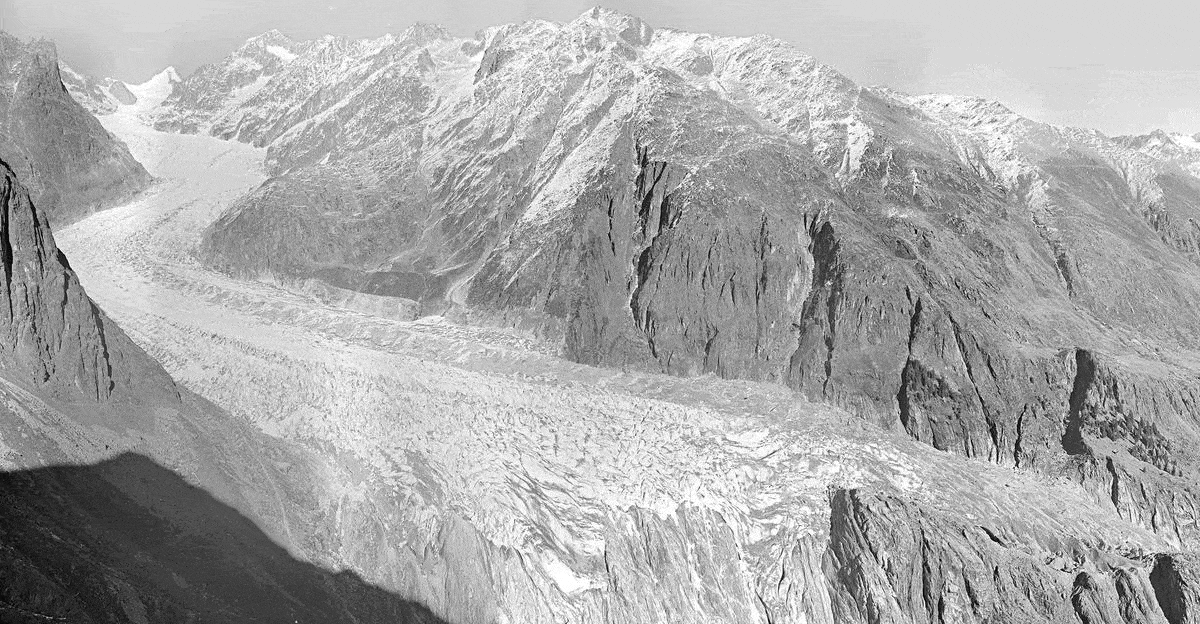Swiss Glaciers Shrank to Half Their Size Since 1931
Historical images reveal dramatic change in Alpen ice coverage
:focal(750x493:751x494)/https://tf-cmsv2-smithsonianmag-media.s3.amazonaws.com/filer_public/f0/bf/f0bf559f-299a-4bb2-bd7a-5864286156e0/gletscherschwund-schwarzsee-2022-220822.jpeg)
As climate change accelerates ice loss around the world, glaciers in the European Alps are no exception. Temperatures in this mountain range are warming about twice as quickly as the global average, per Reuters’ Emma Farge and Gloria Dickie. But scientists hadn’t understood exactly how these glaciers changed during the last century, until now.
In a study published in The Cryosphere, researchers analyzed about 21,700 archival photographs of glaciers in Switzerland between 1916 and 1947. Using these images, they reconstructed the historical topography of nearly all glaciers in 1931—the year in the middle of the range—and compared those to images taken in the 2000s.
“If we know the surface topography of a glacier at two different points in time, we can calculate the difference in ice volume,” lead author Erik Schytt Mannerfelt of ETH Zurich and the Swiss Federal Institute for Forest, Snow and Landscape Research explains in a statement.
Switzerland is home to around half of all glaciers in the European Alps, writes Jamey Keaten for the Associated Press. But the country’s glaciers were reduced by 50 percent between 1931 and 2016, according to the study. Since 2016, melting has accelerated, and the glaciers have declined by another 12 percent.

The team found that not all areas have melted at the same rate. Altitude, debris and glacier shape all affect how quickly the ice retreats, reports the AP. The researchers did find two periods of glacial growth, in the 1920s and 1980s, though the broader trend was of decline, per the publication.
Alpen glaciers are a crucial reservoir, storing freshwater for drinking and agriculture in Europe, writes CNN’s Rachel Ramirez. These staggering ice formations also draw more than 120 million tourists for ski and adventure sports, writes the Washington Post’s Kasha Patel. Aletsch Glacier in Switzerland, the Alps' largest and longest glacier, was declared a UNESCO World Heritage Site in 2001.
Losing glaciers "means losing our national heritage, our identity," hiker Bernardin Chavaillaz told Reuters last month. "It's sad."
This year’s melt season has been particularly extreme because of less winter snow and a few summer heatwaves. In July, 11 hikers were killed when a chunk of ice broke loose from a glacier in Italy.
“I would say it is off the charts compared to anything we’ve ever measured before,” Mylène Jacquemart, a glaciologist at ETH Zurich, said in an email to the Post. “We are currently seeing conditions that, even in a pretty bad year, we would only expect at the very end of the season. When we calculate the final mass balance at the end of September, I expect that it will be the worst year on record by a large margin.”
Researchers estimate that if greenhouse gas emissions continue rising, glaciers in the Alps will lose another 80 percent of their mass by 2100, per Reuters. Even if the world hits targets set in the 2015 Paris Agreement, glaciologist and study co-author Daniel Farinotti tells CNN that scientists expect a 60 percent loss by the end of the century.
“If climate change were to continue unabated, we might well find ourselves with European Alps that are virtually ice-free,” Farinotti tells the publication.
/https://tf-cmsv2-smithsonianmag-media.s3.amazonaws.com/accounts/headshot/MargaretOsborne.png)
/https://tf-cmsv2-smithsonianmag-media.s3.amazonaws.com/accounts/headshot/MargaretOsborne.png)